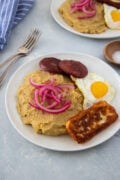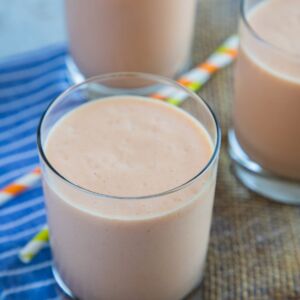Mangú is a popular Dominican side dish that’s made with mashed plantains and can be served with meat, eggs, and cheese. See how to prepare mangú here.
Creamy, rich, and delicious, mangu is one of my favorite plantain-based recipes. Not only is it very simple to make, it’s also very versatile as you can make it the main dish for either breakfast, lunch, or dinner. Served with quick pickled red onions, this is an easy and nutritious recipe full of potassium, vitamin c, magnesium, and many other benefits that make for a wonderful meal.

If you’re like me and you love plantains, then you have to try this easy and delicious mangu recipe! Ready to serve in 30 minutes, you just need a few simple ingredients to make this traditional Dominican dish.
Be sure to try my Stuffed Plantain Cups (Tostones Rellenos), Tostones (Fried Plantains), and all my other favorite plantain recipes too!
What is Mangú?
Mangú is traditionally made by mashing boiled green plantains with a mix of its water, oil, and/or butter. It is heavily influenced by African cuisine as it comes from Africa’s Congo Region which was brought to the island during the slavery trade. While plantains had first arrived in Santo Domingo from the Canary Islands in the early 1500s, it was already an established crop in West Africa.
Presales are open!
The Dominican Kitchen is a collection of 80+ authentic recipes created with easy-to-find ingredients and featuring comforting traditional Dominican flavors. As a thank you to anyone who pre-orders a copy, we are giving out a FREE preorder bundle. Check out our cookbook page for more details.

Why is it called “Mangu“?
There’s an old tale that has gone around for years among the Dominican, New York diaspora about the origin of its name based on American soldiers who tried mangú during *one of the* American occupations of the Dominican Republic reacting that it’s “man, good” or “mad good.” Locals believed that this was the name of the meal in English. However, there’s no actual proof that this is how the dish got its name.
Historically, the word mangú actually comes from the West African word akin to “mangusi,” which refers to any mashed vegetable from the earth. The dish also goes back two centuries ago with the Cuban dish of “fu-fu,” which is the closest dish to mangú.

Ingredients
To make the mangu
- Green plantains – Avoid using plantain if there’s any sight of it turning yellow, making it close to ripening. Green plantains is the best type of plantain to look for this specific recipe as mangú is not meant to be sweet.
- Salt – for flavor!
- Water – This is to help mash the plantains. Although the boiled plantains will already contain some water, this is good to have on hand if it’s still missing some moisture. Some may also use milk, which is another option if you’d prefer.
- Butter – This is used mainly to help soften the plantains while mashing, but is also good for flavoring as opposed to regular cooking oil.
To make the onions
- Red Onions – Full of anti-carcinogenic, antiviral, antibacterial, and other antioxidant properties, onions are always a great added ingredient for more added flavor. Red onions are most often used when garnishing mangú and I also prefer it, rather than white onions for its strong taste.
- Apple Cider Vinegar – adds flavor and adds a bit of acidity to the onions. I enjoy the taste of apple cider vinegar, but you can use white vinegar if that is what you have on hand.
- Salt – more flavor!

How to make mangu
- Peel the plantains and cut lengthwise, then divide each half into two. Check out my post on How to Peel Plantains quickly and easily.
- Add the plantains to a pot and boil over a medium high heat in enough water to cover them and salt until they are very tender.
- Remove the plantains from the water and mash them right away with a fork until they are very smooth and there are few to no lumps. Mix in butter, and water. Keep mashing and mixing until smooth.

For the onions
- Cut onions into thin slices as seen below. In a small bowl combine onions, vinegar and salt. Let sit for about 5 minutes.
Heat a tablespoon of oil in a small or medium skillet over low heat. Add onions and cook while stirring until they become translucent about 1-2 minutes. Garnish mangú with onions.
Serving
What to serve with Mangu?
Mangú can be eaten on its own, but I love to serve it for breakfast with fried or scrambled eggs, Dominican fried salami, and fried cheese, so delicious! You can easily serve this up as a delicious side dish too, it’s great with Fried Pork Chops or Dominican Braised Chicken.
Los Tres Golpes (Three Strikes)
One of the main dishes mangú is popular for is what’s known as the ultimate Dominican breakfast, because it is truly the ultimate breakfast of Dominicans. To make mangú con los tres golpes, you just serve your mangú with a side of fried cheese, Dominican salami and egg.

Frequently Asked Questions
Mangú and mofongo are two similar dishes that differ in very significant ways. Because mangú is made by boiling the plantains first and then mashing them, the texture is essentially much smoother and creamier, similar to mashed potatoes. However, mofongo is made by instead frying the plantains like you would to make tostones and also mashing them, making it a crispier dish than that of mangú.
Make sure to use green (unripe) plantains for this recipe, not yellow (sweet plantains). Green and yellow plantains have different flavors and are not interchangeable. Save the yellow plantains for this Sweet Plantain and Picadillo Casserole instead!
It’s preferable to serve this dish as soon as it’s made for optimal taste and texture. If you have any leftovers try keeping them in the fridge no longer than a day or two. Reheat it on low heat in a pan, stirring occasionally. Add in a little extra water when you reheat it or it will be too dry.

Recipe Notes and Tips
- Mangu gets harder as it cools down. For a smooth mangu, make sure to add room temperature water when mashing. Add the water in stages as you mash, but make sure to add as much water as you need to make it really smooth.
- Mash the mangu using a fork to break it down well.
- PRO TIP: You can also use an immersion blender to make the mangu really smooth.
More Breakfast Recipes

Mangu (Dominican Mashed Plantains)
Author:Ingredients
To make the mangu
- 3 green plantains
- ¾ teaspoon salt
- 1/2 cup water, at room temperature
- 2 tablespoons butter, unsalted
To make the onions
- ½ cup red onions, sliced
- 1 tablespoon apple cider vinegar
- pinch of salt
Instructions
For the mangu
- Peel the plantains and cut lengthwise, then divide each half into two.
- Add the plantains to a pot and boil in enough water to cover them until they are very tender. Add salt to the water before the water breaks the boil.
- Remove the plantains from the water and mash them right away with a fork until they are very smooth and there are few to no lumps. Mix in butter, and water. Keep mashing and mixing until smooth.
For the onions
- In a small bowl combine onions, vinegar and salt. Let sit for about 5 minutes.
- Heat a tablespoon of oil in a skillet over low heat. Add onions and cook while stirring until they become translucent, about 1-2 minutes.
Serving
- Garnish mangu with the onions and serve with eggs, Dominican fried salami and fried cheese.
Notes
- Make sure to use green (unripe) plantains for this recipe, not yellow (sweet plantains). Green and yellow plantains have different flavors and are not interchangeable.
- Mangu gets harder as it cools down. For a smooth mangu, make sure to add room temperature water when mashing. Add the water in stages as you mash, but make sure to add as much water as you need to make it really smooth.
- Mash the mangu using a fork to break it down well.
- PRO TIP: You can also use an immersion blender to make the mangu really smooth.
Nutrition
The nutritional information of this recipe and all recipes on mydominicankitchen.com is only an estimate. The accuracy of any recipe on this site is not guaranteed.






Let us know your thoughts!